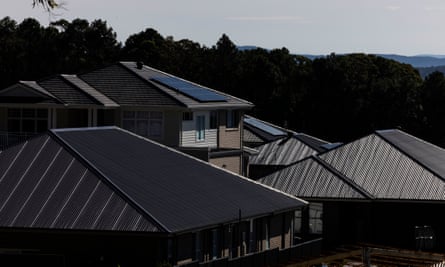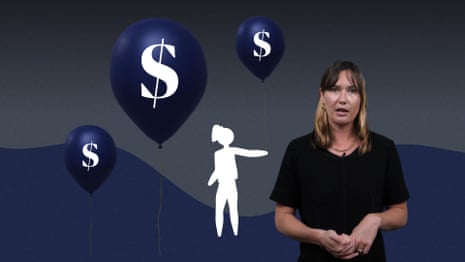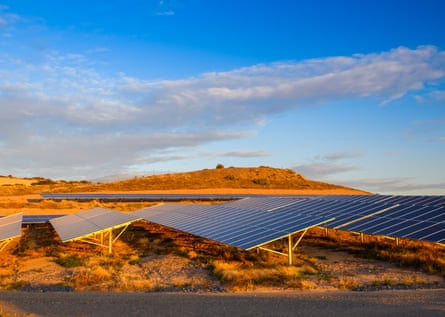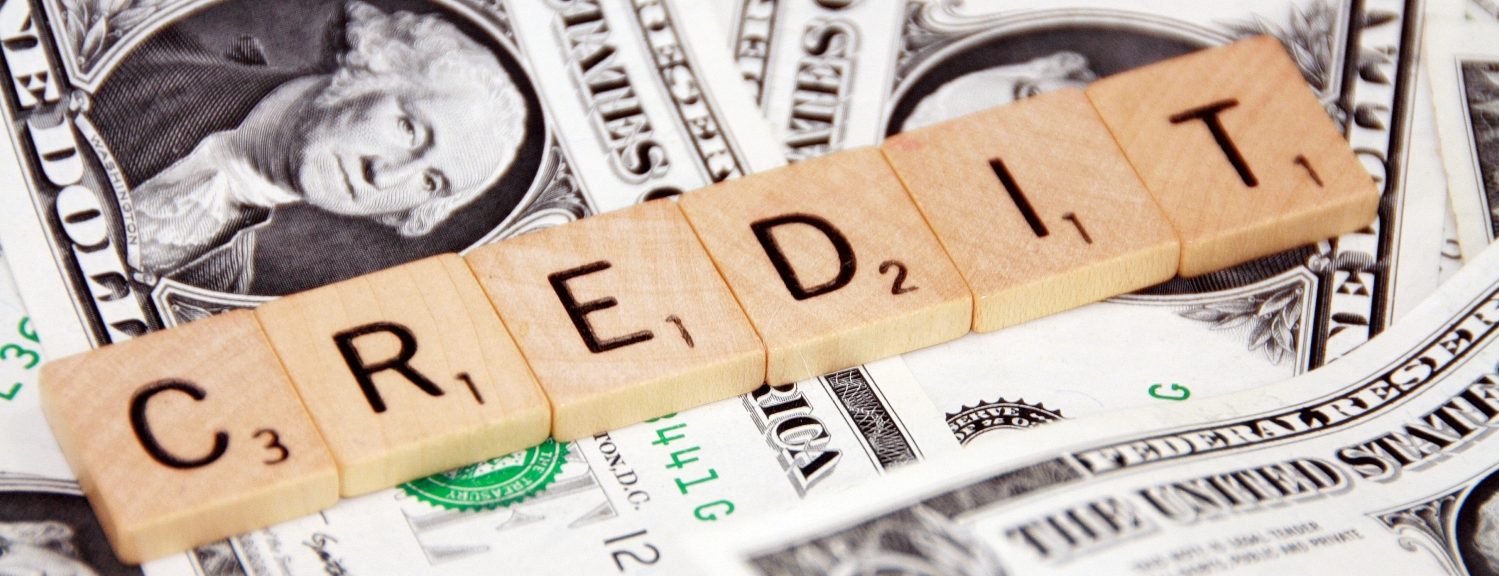Soaring inflation. Rising interest rates. Rental price hikes. Few of us are immune to the current cost of living crisis, with Finder’s consumer sentiment tracker revealing four in five Australians are feeling stressed about their financial situation.
But what can realistically be done about it? We asked the experts for their most concrete cost-cutting measures across the five biggest areas of household expenditure.
Groceries
 View image in fullscreenConsumers are often advised to buy in bulk, but there are other ways of making sure your weekly shop goes further. Photograph: Jacobs Stock Photography Ltd/Getty Images
View image in fullscreenConsumers are often advised to buy in bulk, but there are other ways of making sure your weekly shop goes further. Photograph: Jacobs Stock Photography Ltd/Getty Images
Finder’s consumer sentiment tracker found that the average Australian household spent $188 on their weekly grocery in March 2023 – up $30 a week compared to March 2022, or a $1,560 increase a household over 12 months. The cost of food has been a key factor in rising inflation. Often consumers are advised to buy in bulk, which can offer considerable savings – but for households facing cashflow issues, the upfront expense can be stressful or prohibitive. Here are some other ideas.
Switch up where and when you shop
Flexible schedule? Shop at centres where the major supermarkets are close to a discount grocer, which exposes you to savings you can’t find while doing online comparisons. Individual supermarkets have some discretion in pricing, especially to compete with local shops. Finder’s Sarah Megginson also suggests hitting the supermarkets close to closing time, where you can buy meat and poultry “discounted by up to 80%”.
Millions of Australians face higher Help and Hecs debts: see how inflation will change your student loan repaymentsRead more
Relative cost efficiency: Medium to high. At the time of writing, a 200g punnet of grape tomatoes cost $4 at Woolworths and $4.90 at Coles, but you could get three 200g punnets for $5 at the grocer. Meanwhile, a $10.50 pack of Coles five-star beef mince can be scored for $2.10 on its use-by date.
Effort level: Low to considerable, depending on your schedule – though it might all be gone by the time you get there.
Buy refillable products
Consumer group Choice says the market for refillable products is growing – with refills now available for cleaning products, shampoos and conditioners, and some food items (honey, tomato sauce and barbecue sauce). Some Coles and Woolworths stores now feature refillable stations, too.
Relative cost efficiency: Varied. Choice assessed 71 refillable products including hand wash, shampoo and conditioner, and various cleaning supplies. All of them were cheaper per 100mL than their original counterparts, with an average saving of 32%.
Effort level: Low, pending storage space.
Buy frozen, tinned and imperfect foods
“It’s often cheaper to buy frozen or canned foods, especially if what you want is out of season,” says Finder’s Amy Bradney-George. “The nutritional value is similar to that of fresh foods, [and] frozen and tinned foods are typically processed soon after being harvested, which also preserves the flavour.
“Sometimes the texture will be different to fresh, particularly with tinned foods, which makes them a safer bet in things like curries and casseroles than as a side dish.”
Relative cost efficiency: Low to medium. Varies depending on item, but some canned vegetables start at $1.10 and bags of frozen vegetables start at $3. As a direct comparison, a 500g tray of fresh corn cobs at Woolworths was priced at $3, while a 1kg bag of frozen corn cobs was $4.95. There’s also less likelihood they’ll expire in your fridge.
Effort level: Low. In fact it’s so much more convenient than regular shops.
Recreation
 View image in fullscreenCycling between different subscription services can save you a few bucks a month. Photograph: Olivier Douliery/AFP/Getty Images
View image in fullscreenCycling between different subscription services can save you a few bucks a month. Photograph: Olivier Douliery/AFP/Getty Images
According to Finder, 36% of Australians have cut back on movies, sports and concerts: but there are ways to save, whether going out or staying in – you just have to get creative. Social media coach Emily-Rose Hills encourages people to look to local social media accounts in their local area for unwanted items, community-oriented deals and savings-based hashtags to maximise any affordable fun. And don’t forget incentives (such as discount movie tickets) through services you’re already utilising, like your health insurance or phone plan.
Join a library
“With over 1,500 public library service points across Australia, everyone has access to a library,” says Cathie Warburton, the CEO of the Australian Libraries and Information Association. “You can access free wifi, computers, books, magazines, audio books, movies and newspapers.”
Libraries are also a great place to source DVDs for the programs that aren’t available on your streaming service, and, through government lending schemes, Australian authors can make a small royalty on all books borrowed through local libraries and their BorrowBox apps – so it’s a win-win.
For housing to be affordable, prices must go down, not up. Here’s how it could happen | Matt GrudnoffRead more
Relative cost efficiency: High – it’s entirely free. You’re saving $32.99 on an average new Australian book release, or $89.99 on a BritBox subscription, simply by borrowing Pride and Prejudice on DVD instead.
Effort level: Low.
Cycle through streaming services
Watch everything you want on Netflix for three months. Switch to Stan for the next three. And then Disney+ for three months after that. Stream “cycling” means pausing subscriptions to avoid paying for multiple services at once.
Relative cost efficiency: High, if you’re paying for multiple services. Australians have an average of 3.4 streaming subscriptions each at any given time. Monthly subscriptions range in prices, with minimum service tiers anywhere from $7 to $14 a month. Cutting a single service temporarily is a total cost-saving, while cutting three could save over $30 a month.
Effort level: Low to medium.
-
Sign up for Guardian Australia’s free morning and afternoon email newsletters for your daily news roundup
Attend book launches
All over Australia, book launches offer a dose of culture for zero cost. You can hear authors converse about their inspirations and listen to readings at your local book store. Fancy hearing festival content but can’t afford a ticket? Sign up to the newsletters of your favourite writers’ festivals for news of event recordings dropping on your fave podcast app.
Relative cost efficiency: High. Book launches featuring authors in conversation are often free, compared against writers’ festival tickets which typically range from $25 to $50 (although some festival events are free).
Effort level: Low – if you live near a bookshop and don’t hate leaving the house.
Swap gyms for videos and apps
A gym membership (with no classes) at a national chain could cost from $7.95 a week, while a membership with classes could set you back at least $15.95 a week. Switching to free YouTube classes or following an app-based program could save hundreds – although quality isn’t guaranteed.
Relative cost efficiency: High, provided there are no cancellation fees at your gym. YouTube videos are free; apps such as Sweat by Kayla Itsines and Apple Fitness are $119.94 and $119.99 a year respectively, and a set of three pairs of lightweight dumbbells can cost about $50 on sale.
Effort level: Medium. You’ll need to store your equipment at home, but not having to head to the gym is a serious time-saver. (I made the switch to YouTube after my third child and haven’t looked back.)
Transport
 View image in fullscreenA few cents’ difference in fuel prices can mean major savings over the course of a year. Photograph: Diego Fedele/AAP
View image in fullscreenA few cents’ difference in fuel prices can mean major savings over the course of a year. Photograph: Diego Fedele/AAP
As recently as March, Finder found that 26% of Australians said paying for petrol was one of their top three most stressful expenses, with petrol prices the reason that 13% of Australians (or 2.6 million drivers) want to ditch conventional cars. But while the shift is on, new electric cars remain on average more expensive and the secondhand market is still only emerging.
Stuck with the car you own? Be warned: saving in this category requires significantly more lifestyle changes.
skip past newsletter promotion
Sign up to Afternoon Update
Free daily newsletter
Our Australian afternoon update breaks down the key stories of the day, telling you what’s happening and why it matters
Enter your email address Enter your email address Sign upPrivacy Notice: Newsletters may contain info about charities, online ads, and content funded by outside parties. For more information see our Privacy Policy. We use Google reCaptcha to protect our website and the Google Privacy Policy and Terms of Service apply.
after newsletter promotion
Priced out: how Australians are being hit by the soaring cost of foodRead more
Compare fuel prices
“Very often, cheaper fuel can be one suburb or even one street away, so motorists should use the fuel comparison apps to look for a better price,” says Compare the Market’s Chris Ford. “Also pay careful attention to the fuel discounts available through your supermarket’s rewards programs, any offers you can utilise through roadside assistance programs and if you can redeem a shopping discount for a lower price.” 7/11’s fuel app even allows you to find a low price and “lock it in” to use anytime in seven days.
Relative cost efficiency: Possibly medium. Ford says that the difference between the cheapest and most expensive prices in a given timeframe could be as much as 40c a litre, which could be a saving of $20 for a 50-litre tank – a savings of more than $1,000 a year if you fill up once a week.
Effort level: Low.
Get a rebate on your tolls (or don’t take toll roads)
NRMA’s Peter Khoury says frequent toll road users could be eligible for rebates depending on their state and territory, but not using toll roads is worth considering. “For every toll road, there’s an alternative,” he says.
It costs nothing to apply for a toll rebate, but not taking a toll road could cost you more in time and petrol, depending on the journey.
Relative cost efficiency: In NSW, eligible motorists who spend more than $375 a year on tolls can receive a 40% rebate, potentially saving up to $750 for the financial year; sole traders who spend more than $375 a year on tolls can claim up to $1,500. Until mid-2024, eligible Brisbane residents can receive $100 of toll credit to their Linkt account for use on all toll roads.
Effort level: Medium to high. Rebates are relatively simple to apply for; changing your travel plans is route dependent.
Hack public transport
Whether it’s free trips before 7.15am (Melbourne), a 25% discount on trips with automatic loading of your SmartRider account (Perth) or a 5% discount on all trips with the direct debit option on MyWay (Canberra), there are discounts to be had on public transport around the country. In Sydney, weekend travel is capped at $8.40 for adults and people can score half-price fares on the Opal network after eight trips in a week, leading some to take eight super-short trips before longer travel.
Relative cost efficiency: Medium to high. Switching to public transport can save thousands of dollars a year on petrol, registration, insurance and tolls, according to reports. For those already using public transport, small changes can yield moderate savings.
Effort level: Varied. Those living away from metropolitan areas may struggle and there are always delays to contend with. And who has time to take unnecessary trips to score a discount?
Housing
 View image in fullscreenAustralia’s current housing crisis is making saving strategies extremely difficult for renters – but there is more flexibility available for mortgageholders. Photograph: Jessica Hromas/The Guardian
View image in fullscreenAustralia’s current housing crisis is making saving strategies extremely difficult for renters – but there is more flexibility available for mortgageholders. Photograph: Jessica Hromas/The Guardian
According to Finder, rent and mortgage stress reached a record high in March 2023, with 42% of Australians ranking repayments as one of their top three most stressful expenses. Australia’s current rental crisis unfortunately means that no expert was able to offer savings strategies for renters beyond cutting their spending in other areas. A 2023 report by SGS Economics and Planning found that 42% of all low-income households were paying more than 30% of their income on housing, revealing that rental hikes are outpacing wages, and laying the blame on foreign and local investment, which is affecting availability and affordability.
 00:02:53Why is student debt rising if the Australian student loan system is interest-free? – video
00:02:53Why is student debt rising if the Australian student loan system is interest-free? – video
Switch to fortnightly repayments
Sophie Matthews, senior mortgage broker at Compare Club, says making more frequent mortgage payments can have substantial consequences – especially if you get paid fortnightly. “It helps with cashflow but crucially pays down your loan quicker, so you’ll be charged less interest,” she says.
Cost efficiency: No costs or savings in the short term but a lot to gain in the long run. On a $600k no-fee principal and interest loan at 5.6%, a homeowner would pay $3,721 a month, but $1,861 fortnightly. If everything stayed the same (realistically unlikely), that’s $90,296 less paid in interest and the loan would be paid out 3 years and nine months earlier.
Effort level: Low. It should take your lender a few minutes to make the switch.
Refinance
“Usually if you go into your bank branch and ask for a rate reduction the bank will say no,” says mortgage broker and financial planner Chris Carlin. “[Asking] for a discharge form shows that you are serious about leaving the bank. A member from a retention team will usually contact you and this is when the best offers will come out.”
Relative cost efficiency: A somewhat moderate saving on a substantial expense adds up. At 6.5% on a no-fee principal and interest loan for a 25-year $600,000 mortgage, repayments may be about $1,869 a fortnight. A drop to 5.9% will save you $103 a fortnight.
Effort level: There’ll be forms to sign but most lenders let you do this online. The biggest effort for the homeowner is really putting aside the time to get your documents in order.
Switch lenders, score cash
“[When] refinancing with a new lender via a broker there’s a good chance you’ll be able to find a cashback offer,” Matthews says. “The amount you can get varies … but $2,000 cashback is pretty achievable.”
Relative cost efficiency: A quick cash gain and substantial ongoing savings. A lower repayment rate plus $2,000 cashback is pretty standard these days. Brokers make a commission from the lender and shouldn’t charge the client.
Effort level: High. Refinancing via a broker will typically take between four and six weeks for a straightforward loan, although some lenders can do it faster. If you’re in a hurry, ask your broker for a lender with a fast refinance process.
Energy
 View image in fullscreenPaying attention to your energy bill could help save hundreds – especially if you shop around. Photograph: moisseyev/Getty Images/iStockphoto
View image in fullscreenPaying attention to your energy bill could help save hundreds – especially if you shop around. Photograph: moisseyev/Getty Images/iStockphoto
Finder analysis shows staying loyal to an existing energy provider could cost the average Australian $168 a year, so it pays (literally) to shop around.
Change electricity suppliers
“Don’t wait until 1 July when the new default market offer prices come into effect to make your move,” says Meredith O’Brien, head of energy at Compare the Market. “Pay close attention to whether the plan is fixed or variable, the usage rate, the supply rate, the feed-in tariff, when any discounts or incentives expire and if there are any conditions you need to meet to receive discounts.”
Cost of living 2023: see how inflation has changed prices in Australia in the March quarter – interactiveRead more
O’Brien suggests looking at incentives offered through providers across the country before making the switch, as eligible customers might also snap up rewards points or credits towards future bills, depending on which service they switch to and when.
Relative cost efficiency: Medium – between $120.39 and $206.72 a year –depending on where you live, plus additional benefits and discounts via sign-up incentives. Check the terms and conditions of your current plan, though – beware of cancellation fees.
Effort level: Low effort – it can take as little as two business days.
Monitor your home energy use
According to Canstar Blue, using an energy monitor helps identify opportunities to reduce your bill. Electricity monitoring is available to most smart meter customers; other meter types will require a attachment to access energy monitoring.
Watch the role that appliances play – run dishwashers and washing machines on eco-friendly settings, close curtains and blinds to minimise the need to heat or cool your house, keep appliances maintained so that they run optimally and only buy appliances with great star ratings when shopping for new items. “The higher the rating, the more efficient the appliance is,” says Choice’s Liam Kennedy.
Cost efficiency: A $5 smart meter won’t itself lower your bill, but it can identify the biggest guzzlers of energy in your home.
Effort level: Low to medium – it’s just a matter of setting it up and reading it.




